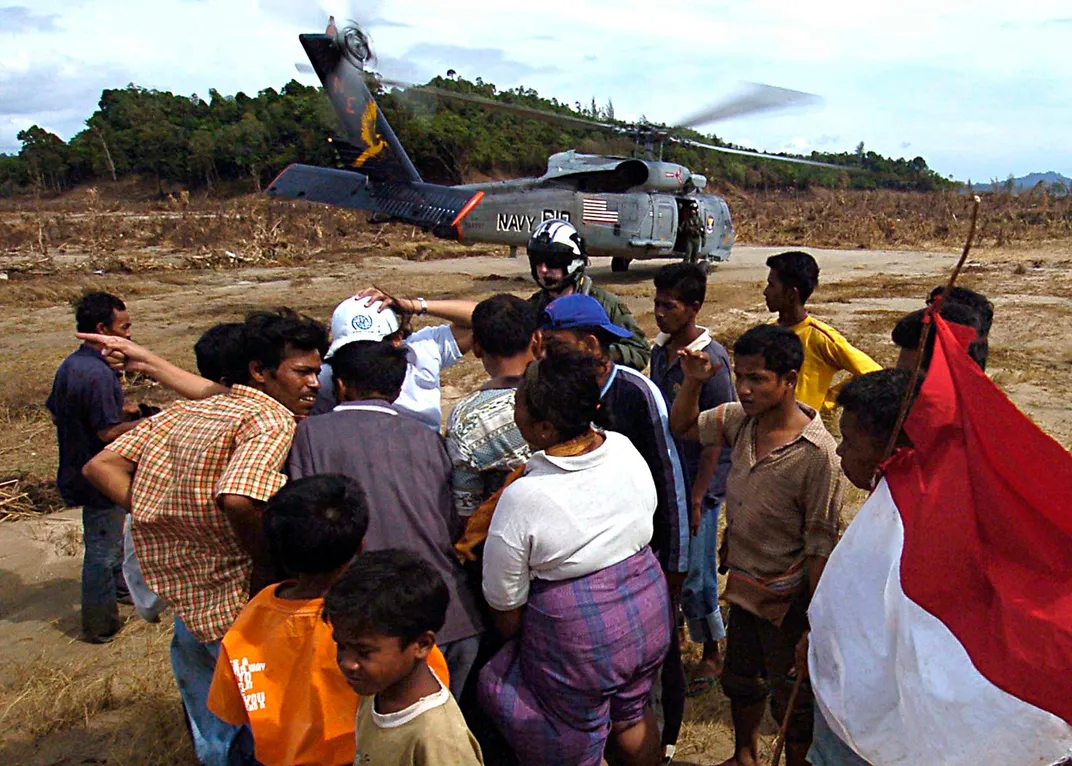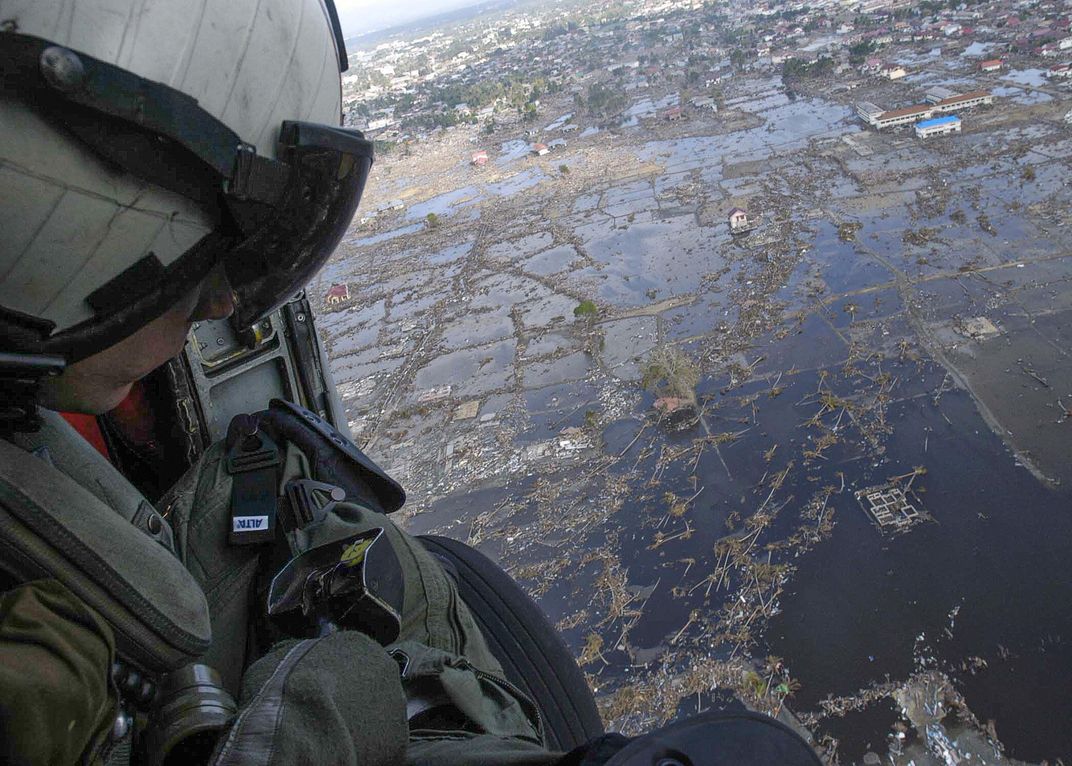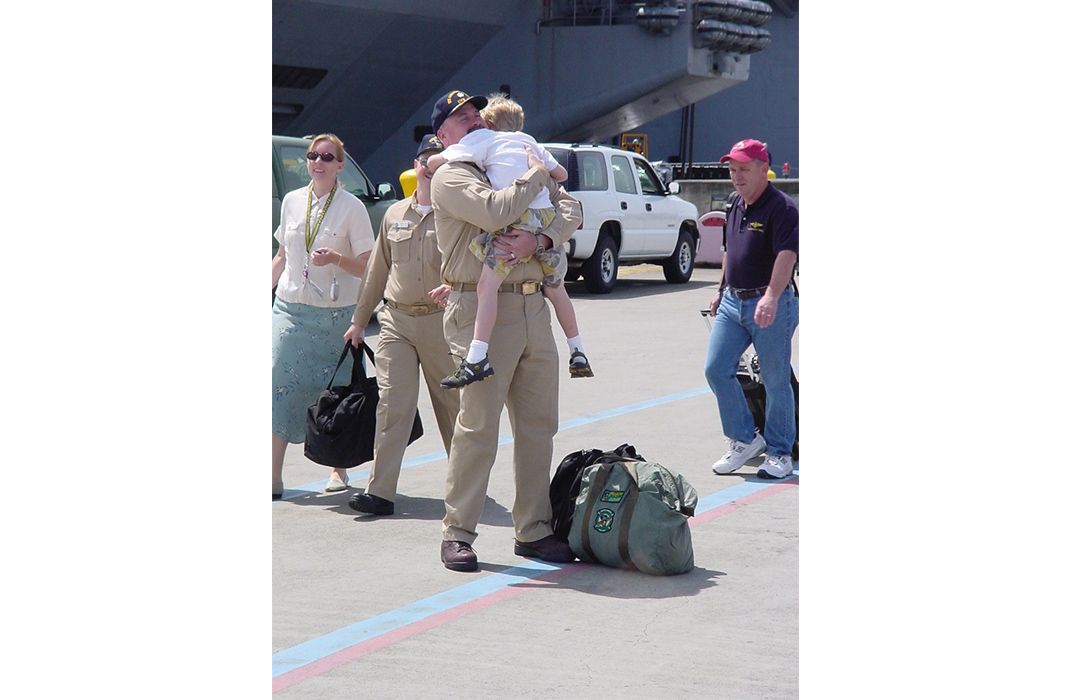Rescue for the Rescuers
In 2004, the USS Abraham Lincoln brought help to tsunami victims, and even to fellow rescuers.
/https://tf-cmsv2-smithsonianmag-media.s3.amazonaws.com/filer/08/e6/08e670ef-0b53-4d76-a8d7-3889b019e71c/17d_on2014_flight3_live.jpg)
The earthquake made the whole planet wobble. On the island of Sumatra, Indonesia, the residents of Banda Aceh were closest to the 9.0 quake’s epicenter, feeling it just before 8 a.m. on December 26, 2004. Minutes later, the tsunami that it triggered washed the town out to sea. In the region, 225,000 people were killed—more than half of them in Banda Aceh.
As one of the 5,500 crew members assigned to the aircraft carrier Abraham Lincoln, on a port visit nearby in Hong Kong, I was in a hotel when CNN began reporting on the disaster. The commander of our strike group ordered us to head out, on what would soon be called Operation Unified Assistance.
I was the ship’s assistant air department officer, working in the carrier’s tower and in control of all daylight flight operations. As we approached the Sumatran shore on New Year’s Day, sunrise revealed the horrifying situation, which I described in an email home: “We have passed scores of dead bodies (both human and animal) with massive amounts of debris in the water. I think the worst thing I saw today were two dead bodies on top of a wooden raft (most likely a wall from a house).”
The carrier’s helicopter crews began hauling supplies to shore, and we quickly discovered that we couldn’t fill the water jugs fast enough. There were only a few potable water spigots on the flight deck, but plenty of water: The nuclear reactors that power the carrier distill 400,000 gallons of water per day as a by-product. Sailors from the engineering department took up the challenge to speed up the loading by raiding the spare plumbing parts bin and building us a 20-spigot manifold. From then on, every helicopter took off loaded to capacity.
Early on January 3, all flights into Banda Aceh were suspended. While attempting to land, an Asian Airlines 737 carrying supplies had collided with a water buffalo, collapsing the airliner’s left main landing gear. Three United Nations personnel had been trying to move the stricken jet—now blocking all flights in and out—for 15 hours, while no one could land and eight jets sat trapped on the tarmac, waiting to go retrieve more supplies. To clear the runway I sent in a two-man team: the aircraft handling officer, Shawn Whalen, and the flight deck crash and salvage officer, Tom Hoctor. Tom is solidly built and slightly cross-eyed, which he blames on being hit in the head in 1995 by an A-6 canopy that had been inadvertently jettisoned.
They got back three hours later, and Shawn described the scene: “They had a bunch of air bladders underneath the left wing, and had tried to raise it so they could get a trolley under the wingtip, but the bladders kept shooting out when they put air in them. We tried lifting the left wing with a forklift and putting the wingtip on a dolly, but the dolly started sinking into the runway. And the pressure was on—when all the stranded pilots sitting on the ramp saw us heading to the crash site, they started their engines, taxied to the end of the runway, and waited to take off.”
Working with the UN team, Shawn and Tom came up with a plan. They took the two forklifts and speared an engine, one in front and one from behind, and began to drive in unison. Finally the jet started moving. They got the aircraft out of the way just as a Singapore air force C-130 took off over their heads.
During lunch one day, one of the many parents in the carrier’s crew lamented that we didn’t have any toys on board for the town’s kids. I thought of my son’s Hot Wheels car, sitting on my desk, which he loaned me upon deployment in case I got “bored.” I emailed my wife, who confirmed our son was fine with the toy going ashore. I passed the lime green car along to an airman, asking if he would give it to a kid. When the crew returned, I headed down to see how it went. The airman smiled: “We landed close to an orphanage and one boy, probably about four years old, was standing away from the crowd by himself. I walked up to him and gave him the car. The boy gave me a big smile.”
The next day’s flight operations began with a dawn launch of eight helicopters carrying volunteers ashore. About 20 minutes after they departed, a call came over the radio: “Hunter 613 is down!” The helicopter had crashed; in the hot, humid conditions, the tail rotor was unable to counter the torque of the main rotor. Luckily, the Seahawk had landed in a rice paddy, which was spongy, and with seven other helicopters at the scene, they were able to rescue the injured immediately.
Now the Seahawk itself had to be recovered, but moving a crippled helicopter is a daunting task. The engine makes the airframe top-heavy, the main rotor blades stick out and can act like wings to roll the helicopter, and worse, they might hit the lifting helicopter’s rotor blades, like two eggbeaters grinding together at different speeds. We had to find an experienced salvage team, as well as a helicopter with enough lift capacity, to retrieve the Seahawk.
Shawn put together a team of volunteers who took every metal cutting blade they could find on the ship along with some of the biggest wrenches and hammers known to man. They fashioned an impromptu harness to fit over the rotor head of the downed helicopter. In a stroke of luck, a Marine Corps helicopter squadron had recently arrived in the area; its powerful CH-53 Sea Stallion would certainly be able to lift the chopper.
Unlike the airliner salvage operation, the Seahawk recovery effort was, the team reported to me later, “a hateful slog.” Working all day under the beating sun and high humidity, they slowly ground through the four titanium rotor blades, while the helicopter lay on its side in the muck of the rice paddy.
The rotors finally lost the battle to the saw blades, and the airframe was readied for pick up. When the Marines arrived and hovered in place above the Seahawk, their Sea Stallion’s powerful downwash created a cyclone of swirling mud that drenched everything in the vicinity. Once the airframe was harnessed, the Marines lifted the stricken helicopter out of the mud and carried it over to solid ground for a final check before continuing on to the Lincoln.
As soon as we were informed that the wreck was en route to the carrier, we started watching for the inbound flight. One of the tower spotters pointed it out about the time we received the radio call. “Union Tower, this is Lady Ace 21, a flight of two. One CH-53 carrying a broke Seahawk, seven miles out and inbound for a drop off.” This resulted in an immediate call from the ship’s commanding officer. “What did he say, Hoss? I’m not sure I heard that right.” After mumbling something about how nice it was for our Marine Corps brethren to help us out, I excused myself to get back to the recovery.
The Marines expertly dropped the salvaged helicopter onto the deck, then departed again for Sumatra. The salvage team arrived shortly after, and not a single team member was seen for about a day. Some were exhausted, but most said it took them that long to wash all the mud off.
Forty-eight Navy and Marine Corps helicopters flew in support of Operation Unified Assistance, transporting 2,929 passengers, and delivering 5.7 million pounds of food, water, and medical supplies ashore, along with one green Hot Wheels car.


